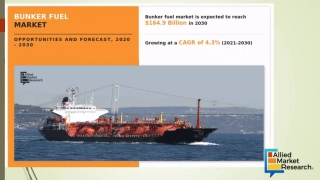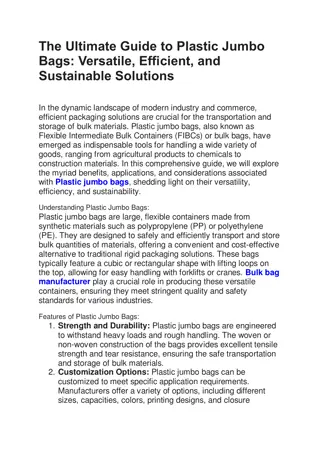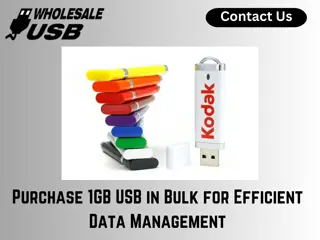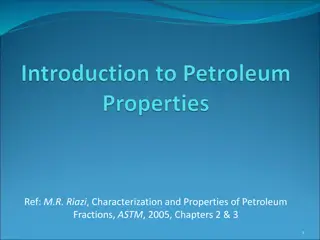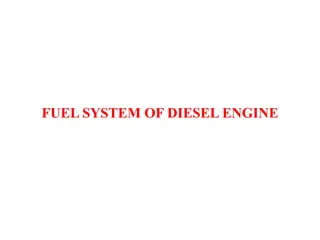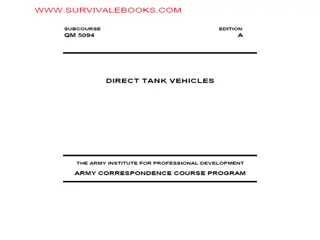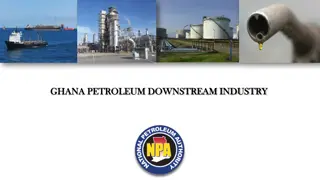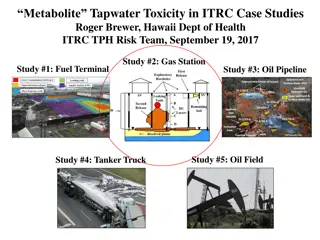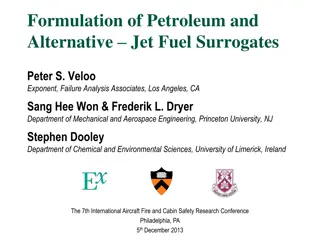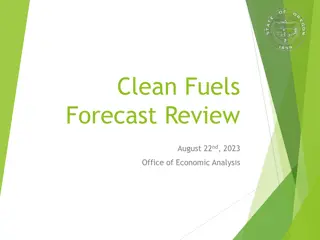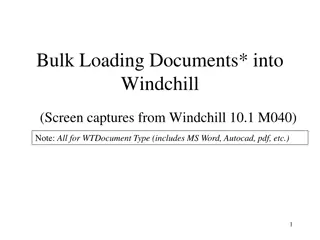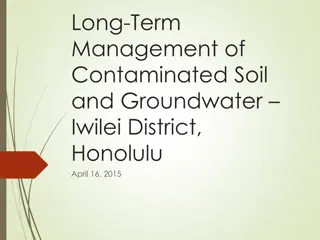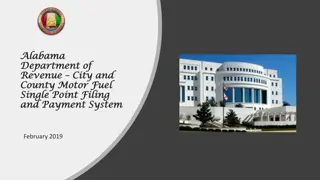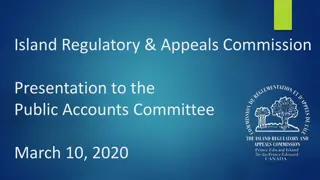Bulk Petroleum Products Handling Procedures at Fuel System Supply Point
Learn how to receive and issue bulk petroleum products using the Fuel System Supply Point (FSSP) in the army. This training covers safety precautions, procedures, and best practices for handling petroleum products efficiently and safely in the field.
Download Presentation

Please find below an Image/Link to download the presentation.
The content on the website is provided AS IS for your information and personal use only. It may not be sold, licensed, or shared on other websites without obtaining consent from the author.If you encounter any issues during the download, it is possible that the publisher has removed the file from their server.
You are allowed to download the files provided on this website for personal or commercial use, subject to the condition that they are used lawfully. All files are the property of their respective owners.
The content on the website is provided AS IS for your information and personal use only. It may not be sold, licensed, or shared on other websites without obtaining consent from the author.
E N D
Presentation Transcript
INTRODUCTION TO RECEIVE AND ISSUE BULK PETROLEUM PRODUCTS USING THE FUEL SYSTEM SUPPLY POINT (FSSP) The FSSP is the Army's primary means of receiving, storing, and issuing bulk petroleum products to combat forces in the field. RECEIVE AND ISSUE BULK PETROLEUM PRODUCTS USING THE FUEL SYSTEM SUPPLY POINT (FSSP) In Lesson 1, you will learn how to receive and issue bulk petroleum products using the FSSP. To understand the procedures for receiving and issuing bulk petroleum products using the FSSP, you must be able to: 1. Follow correct safety precautions and layout procedures of the FSSP. 2. Receive bulk petroleum products using the FSSP. 3. Issue bulk petroleum products using the FSSP.
Learning Event 1: FOLLOW CORRECT SAFETY PRECAUTIONS AND LAYOUT PROCEDURES Safety Precautions Whenever you are working with petroleum products, there is a risk of fire. This danger can be reduced by following the proper safety precautions during all phases of an operation. The primary precaution is to prohibit smoking near the FSSP. Post "NO SMOKING" signs so that anyone entering or working in the supply point can see the signs immediately. Do not let anyone carry matches or other smoking materials into the supply point. Collect smoking materials at the entrance checkpoint. Ensure that personnel smoke only in designated smoking areas.
Place fire extinguishers at all receipt, storage, and issue points. All fire extinguishers must be operational and inspected daily. Ensure that all equipment is grounded. Follow proper grounding and bonding procedures during fuel transfer operations. If there is an enemy attack, electrical storm, or fire in the immediate area, stop all operations immediately. Disconnect all pump hoses and move all vehicles out of the area, if possible. If fire breaks out at the manhole cover of a tank vehicle or the hinged dome cover of a rail tank car, stop the transfer operation and close the manhole or dome cover. This will extinguish the flames
Do not permit welding, open flames, or lights (other than approved explosion-proof flashlights) within 100 feet of any receipt, storage, or issue operation. When operating a pump and you can see sparks, stop the pump and inspect all grounding and bonding connections. Make sure the connections are bare metal-to-metal contact. If you cannot find any faulty connections, look at the power equipment in the area to find possible cause of stray current.
Maintain a distance of at least 25 feet between tank vehicles during receipt or issue operations. Also, keep all tractors coupled to the semitrailers while product is being transferred. This allows the semitrailers to be moved quickly in an emergency. The canvas top and rear curtain of the tractor must cover the driver compartment when the vehicle is carrying, loading, or unloading product. This keeps the inside of the tractor from being splashed with fuel.
Do not use nozzles that are equipped with locking devices. If you have a nozzle that is equipped with a locking device, disable the locking device before use. Ensure that nozzles are attended constantly when refueling. Take all precautions possible to prevent spills. Use drip pans whenever hoses are being connected or disconnected. Repair all leaks immediately. If needed, replace defective hoses, gaskets, and valves. All personnel must be properly trained and follow all safety precautions. They must know how to properly administer first aid for fuel-related injuries.
Layout Procedures The FSSP consists of two 350 gallons per minute (GPM) pumping assemblies, two 350-GPM filter/separators, six 10,000- gallon collapsible tanks, six bottom-loading points for tank vehicles, two 500-gallon collapsible drumfilling points, six refueling points for filling 5 gallon cans, 55 gallon drums, and retail issues to vehicle fuel tanks. The system's components are connected with approximately 2,400 feet of hose with 11 types of fittings.
The FSSP is designed to be flexible in its layout. The system's layout depends upon the needs of the mission and the variables of the terrain. You must lay out the system and identify the components needed. For example, if your mission does not include filling 500-gallon collapsible drums, then you do not include the filling points in your layout. The FSSP can be used for receiving, storing, and issuing two types of fuel without using any additional equipment. This is done by dividing the system into two smaller components. By splitting your FSSP in half, you can also operate from two different locations simultaneously. This method makes it easier to move and keep up with advancing forces. By moving half of a system at a time, the other half can stay in operation and be moved when the first half is operational. This process is called "leapfrogging."
No matter how the system is laid out, certain requirements must be met. Figure 1 lists the minimum distances that must be maintained between items of equipment. Whether one pump or two are used as part of the same system, there must be both a receiving point and an issue point. The receiving and issue points are separated as much as possible to avoid congestion and possible confusion.
The basic setup for the tank manifold remains the same regardless of the number of tanks used or the layout design. The manifold on each tank must be assembled so that fuel can be received or issued, because the 10,000- gallon collapsible tank has only one filler- discharge port. The basic manifold for each tank is shown in Figure 2.
Various ways of laying out a complete FSSP are shown in Figure 3. Lay out the system the best way possible for your specific situation.
After you decide how to lay out the system, you must prepare the areas where the tanks will be positioned. Pick up all loose debris. Each collapsible tank must be surrounded by a firewall (also called a berm). This firewall must be large enough to contain the entire contents of the tank plus one foot of freeboard (empty space). To meet this requirement, the firewall must have an inside diameter of 26 by 26 feet. The firewall must be 3 feet high and 18 inches wide at the top of the berm. Figure 4 displays a berm construction.
When constructing the firewall, a water drain must be installed. This is done by burying a section of hose at lowest point in the base of the firewall. The drain is closed at all times except when draining the water that has collected in the berm.
The area inside the berm are as level as possible with a slight slope of one or two degrees toward the discharge assembly. The slope helps in emptying the tanks. A hole, one foot deep, is dug under the discharge assembly for use as a sump. Use ground cloths to protect the bottom of the tank. These may be canvas tarpaulins or unserviceable tanks. In some areas, ground cloths are required to prevent possible ground contamination in case of leaks or tank ruptures.
The filter/separators are placed in the system so that they can be bypassed for maintenance. If you are using the complete system, place one separator at the receiving side of the system and the other at the issue side. Another alternative is to place both separators at the issue side and connect the manifold so that if one is taken out of service the other can be used. Filter/separators must be placed in the system to permit filtering of fuel during tank to tank transfers.
When your personnel are laying out the hoses for the system, ensure that they only remove dust caps and plugs when they are ready to make the connection. After the connection is made, the dust plugs are placed inside the dust caps to prevent contamination of the hoses. Place the connected caps and plugs under the connection to raise the hose connection off the ground and make it easier to spot leaks. Before the connection is made, be sure the gasket in the female coupling is present and cam locks are serviceable.
Learning Event 2: RECEIVE BULK PETROLEUM PRODUCTS Preliminary Procedures To avoid interruptions and delays, prepare a receiving schedule. Before the product arrives, you are notified of the type and amount of product as well as the date and time of arrival. Before receiving product, inspect pumps, filter/separators, hoses, valves, and fittings for cleanliness and good working condition. Check your collapsible tanks for cleanliness, damage, and available product space for the receipt. Do this before any product arrives at your location.
When the transporter arrives, position it so there is no strain on the hose connections. This is called "spotting." If unloading more than one transporter at the same time, make sure they are at least 25 feet apart. Bond and ground the transporter. Compare the seal numbers on the transporters to the numbers on the shipping documents to detect any tampering. If there is a broken seal or the seals do not match the shipping documents, notify the proper authorities. Do not unload or use the product until it has been gaged, sampled, and tested. If seals are not used on a load, verify the quantity and quality before loading.
Inspect the transporter for leaks. If the transporter is leaking, place a drip pan to catch the leak and unload the fuel at once. Be sure to clean up any spilled fuel immediately.
Unload Tank Vehicles Before starting the unloading operation, make sure the vehicle and the major components in the supply point are bonded and grounded. Place a drip pan under the manifold of the vehicle before making any connections. Make sure you have a fire extinguisher near the receiving point and you follow all safety precautions. Connect the suction hose to the discharge port of the vehicle. Assign someone to watch the level of the fuel as the product is discharged from the vehicle. Make sure the manhole stays open during the operation. Keeping the manhole open prevents the tank shell from collapsing, if the vent valve on the tanker does not work.
Open the discharge valves on the tank vehicle and the suction valve on the 350 GPM pumping assembly in the FSSP. Start the pump, and idle at the appropriate speed for three to five minutes. Lesson 1/Learning Event 2 Make sure the tanks have enough ullage (empty space) to receive the product. While the pump is idling, open the manifold valves of the collapsible tank to be filled. Make sure all the valves between the collapsible tank and the vehicle tank are open except for the pump discharge valve. When the pump warms up, slowly open the pump discharge valve. When the discharge valve is fully open and the product is flowing, slowly increase the pump speed to achieve the desired flow rate.
While the tank vehicle is being unloaded, check the hoses, valves, pump, and receiving tank for leaks. Place a drip pan under any leak and stop the operation immediately. Make any necessary repairs before continuing the operation. When the transporter is empty, idle the pump engine then close the discharge valve. Allow the engine to idle for three to five minutes before turning it off. Close the pump suction valve. Close the manhole and all open valves and disconnect the suction hoses from the transporter and the grounding wire from the vehicle. Have the vehicle moved out of the area and prepare for the next operation
Unloading Tank Cars You may be able to set up your FSSP close enough to a railroad track to receive product by rail tank cars. This will allow larger shipments of fuel and will allow other materials to be moved by vehicle on the main supply route.
When receiving product from a rail car, use a standard car mover to spot the rail car. After spotting, set the brakes and chock the wheels. Place the signs reading "STOP-TANK CAR CONNECTED" between the rails at a distance of at least 25 feet (50 feet is preferred) ahead and behind the rail car. Ensure that the rails are grounded by connecting a wire to both tracks and to a grounding rod. Position fire extinguishers at all unloading points and have drip pans available. A cone shaped wooden plug is also required for use in case the bottom outlet valve is open when the cap is removed.
When the rail tank car is in position and grounded, make a quick inspection for leaks. If you receive a rail car that is leaking, place a drip pan under the leak and unload the car as soon as possible. Perform the preliminary steps to ensure that the product is suitable for use and has not been tampered with. Unload the rail tank car through the bottom outlet valve unless the valve is broken or unless the proper adapter for the rail tank car is unavailable. In these cases, unload the car through the dome with a suction hose.
When opening the manhole cover on the rail car, stand on the upwind side and avoid breathing fumes. If possible, release internal pressure before opening. Check the size of the bottom outlet pipe and get the correct size adapter. If you are using the adjustable (Gossler) coupling, the size is not important. Outlet pipes vary in size from four to six inches so it is important to use the correct size adapter. Connect the suction hose to the adapter and open all valves to the pump suction (Figure 5).
Open the pump suction valve and start the pump. Idle the pump for three to five minutes. While the pump is idling, open the valves between the pump discharge and the receiving tank. Have one person monitor the fuel level in the tank car as it is unloaded. When the pump engine warms up, slowly open the discharge valve. Increase the pump speed to the desired flow rate. While transferring the product, make sure the during-operation maintenance is performed by the pump operator. Also ensure that all hoses, valves, and the tank receiving the product are checked for leaks.
If a leak is found during unloading, place a drip pan under the leak and stop the operation. Make the necessary repairs before resuming the transfer operation. When the rail tank car is empty, slow the pump engine to idle speed and close the pump discharge and all other valves. Allow the pump to idle three to five minutes before shutting it off and closing the suction valve. Close the bottom outlet valve on the rail tank car. Disconnect the suction hose from the rail car and remove the adapter. Replace the outlet cap, and close the manhole cover.
On all sides of the rail car are diamond shaped cards that say "FLAMMABLE". Remove these cards and replace them with "DANGEROUS EMPTY" cards. (NOTE: Some cards are printed on both sides in which case you flip them over.) Disconnect the grounding wire from the rail car, release the brakes, remove the chock block, and move it from the transfer area, or notify the proper authorities that the car is ready to be removed.
Receipt of Product Through the Assault Hoseline In some cases, you may receive product into your FSSP by the assault hoseline. As with the rail tank car, this has the advantage of freeing up the main supply route for other types of supplies. An added advantage is being able to receive more product into your system, assuming there is an adequate source at the other end of the hoseline.
The assault hoseline usually connects directly into your manifold system on the discharge side of your receiving pump. Figure 6 depicts the assault hoseline attached to the FSSP. You can connect the assault hoseline to a 50,000-gallon collapsible tank with this setup. You must have good communications with the pump stations on the hoseline. You must maintain constant contact with the pump station upstream to prevent overfilling and rupturing of your collapsible tanks.
You will receive pumping orders before the operation begins. Pumping orders tell you when the operation begins, how much fuel you are to receive, and how long the pumping operation will take. After receiving the pumping order, ensure that you have enough ullage to receive the quantity designated. You may want to transfer product from partially filled tanks to consolidate the fuel on hand. Doing this can reduce the number of tank switches required during the receipt.
Once you have decided which tanks are to receive the product, then you can determine which valves need to be opened. Remember when you are switching tanks to open the valves to the next tank before closing the valves of the first tank. Failure to follow this procedure results in overfilling and rupturing the tank.
When it is time for the operation to begin, open the valves necessary for the receipt, except for the valve connecting the hoseline to the FSSP. Notify the pump station upstream that you are ready to receive. The pump station operator tells you when to open the final valve and begin receiving product.
When the product starts arriving in the FSSP, check hoses and valves for leaks. Observe the collapsible tank to be sure that you are receiving the fuel, send out a patrol to inspect the hoseline for leaks, damage, and signs of tampering or sabotage. If you are receiving a large amount of fuel into the FSSP, more than one tank is required. When a receiving tank is almost full, open the valve necessary to start the flow of product into the next tank. With product flowing into both tanks, wait until the first tank is completely filled before closing the valve to allow flow into the new tank. Continue in this manner until you have received the entire quantity.
If you are receiving product until your tanks are full, it is your responsibility to notify the pump station operator when to shut down the operation. Remember that you must stop the flow gradually. If you are receiving a specific amount, the pump station operators notifies you when they begin shutting down. If at any time during the receipt there is a fire, enemy attack, or other emergency, notify the pump station operator and shut down the operation immediately. After the receipt is completed, close all valves, perform after-operation maintenance, and prepare for the next operation.
Learning Event 3: ISSUE BULK PETROLEUM PRODUCTS Preliminary Procedures Issuing bulk petroleum is perhaps the most important responsibility you have at the FSSP. You are in the field to provide the consuming units with fuel to perform their mission. In the theater of operations, you issue fuel in bulk as far forward as possible. Usually, the units you support picks up the bulk petroleum from you in their organic vehicles; however, you may sometimes have vehicles assigned to your unit for delivery to the units.
Prepare an issue schedule before any transporters arrive at the FSSP. Start by telling your customer what type and how much fuel you have on hand. Then tell the customer when to pick up the product at your facility. If your transporters are delivering the product, tell the customer when to expect delivery so he can prepare for its arrival. Try to avoid delays and interruptions when scheduling issues. In other words, do not have more transporters at your supply point than you can handle at one time. Also, make sure you have enough product on hand to fill all the requests.
Inspect your pumps, filter/separators, collapsible tanks, hoses, manifolds, valves, and fittings to make sure that they are free of leaks and contamination.
Loading Tank Vehicles When the transporter arrives at the FSSP, position it at an issue point. Attach a ground wire to the transporter. Open the manholes or dome cover and inspect the transporter. (NOTE: The following inspection can be performed at the entrance checkpoint.) Check the inside and outside of the tank for holes, cracks, or loose plates. Make sure there are no leaks in the tank. The tank must be properly mounted to the frame and safe for the road.
Inspect the interior of the tank. If you see any residue such as rust, sand, or dirt, reject the transporter and have it cleaned. Check the interior of the tank for foreign objects such as tools, bolts, or old seals. Have authorized personnel remove objects from the tank
Connect the discharge hose to the receiving port of the vehicle. Three soldiers are needed to load a tank vehicle. Assign one to watch the product as it enters the tank, so that you do not overfill the vehicle. In addition to the person on the vehicle, there must be one person at the vehicle valves and one person at the pump. Coordination between them is important to avoid overfilling.
Open the receiving valves on the vehicle and the manifold valves on the collapsible tank supplying the product. Make sure all other valves between the collapsible tank and the tank vehicle are open. Open the suction valve on the 350-GPM pump assembly and start the pump. Idle the pump three to five minutes to allow the pump to warm up.




